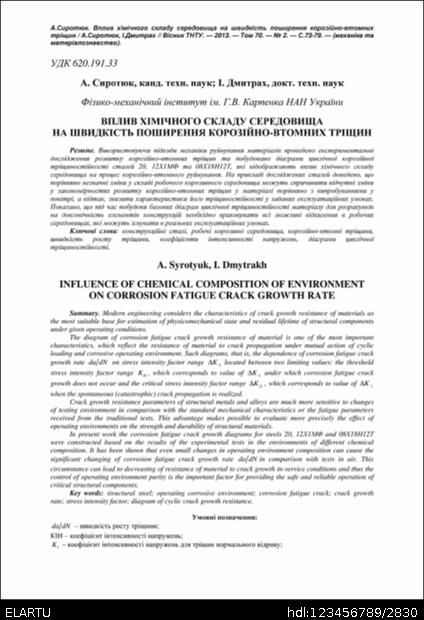Будь ласка, використовуйте цей ідентифікатор, щоб цитувати або посилатися на цей матеріал:
http://elartu.tntu.edu.ua/handle/123456789/2830

| Назва: | Вплив хімічного складу середовища на швидкість поширення корозійно-втомних тріщин |
| Інші назви: | Influence of chemical composition of environment on corrosion fatigue crack growth rate |
| Автори: | Сиротюк, А. Дмитрах, І. Syrotyuk, A. Dmytrakh, I. |
| Бібліографічний опис: | А.Сиротюк. Вплив хімічного складу середовища на швидкість поширення корозійно-втомних тріщин / А.Сиротюк, І.Дмитрах // Вісник ТНТУ. — 2013. — Том 70. — № 2. — С.73-79. — (механіка та матеріалознавство). |
| Дата публікації: | 23-кві-2013 |
| Дата внесення: | 11-лют-2014 |
| Видавництво: | Тернопільський національний технічний університет ім. Івана Пулюя |
| Місце видання, проведення: | Тернопіль, Україна |
| УДК: | 620.191.33 |
| Теми: | конструкційні сталі робочі корозивні середовища корозійно-втомні тріщини швидкість росту тріщини коефіцієнти інтенсивності напружень діаграми циклічної тріщиностійкості structural steel operating corrosive environment corrosion fatigue crack crack growth rate stress intensity factor diagram of cyclic crack growth resistance |
| Короткий огляд (реферат): | Використовуючи підходи механіки руйнування матеріалів проведено експериментальні дослідження розвитку корозійно-втомних тріщин та побудовано діаграми циклічної корозійної тріщиностійкості сталей 20, 12Х1МФ та 08Х18Н12Т, які відображають вплив хімічного складу середовища на процес корозійно-втомного руйнування. На прикладі досліджених сталей доведено, що порівняно незначні зміни у складі робочого корозивного середовища можуть спричинити відчутні зміни у закономірностях розвитку корозійно-втомних тріщин у матеріалі порівняно з випробуваннями у повітрі, а відтак, знизити характеристики його тріщиностійкості у заданих експлуатаційних умовах. Показано, що під час побудови базових діаграм циклічної тріщиностійкості матеріалу для розрахунків на довговічність елементів конструкцій необхідно враховувати всі можливі відхилення в робочих середовищах, які можуть існувати в реальних експлуатаційних умовах. Modern engineering considers the characteristics of crack growth resistance of materials as the most suitable base for estimation of physicomechanical state and residual lifetime of structural components under given operating conditions. The diagram of corrosion fatigue crack growth resistance of material is one of the most important characteristics, which reflect the resistance of material to crack propagation under mutual action of cyclic loading and corrosive operating environment. Such diagrams, that is, the dependence of corrosion fatigue crack growth rate on stress intensity factor range located between two limiting values: the threshold stress intensity factor range , which corresponds to value of under which corrosion fatigue crack growth does not occur and the critical stress intensity factor range , which corresponds to value of when the spontaneous (catastrophic) crack propagation is realized. Crack growth resistance parameters of structural metals and alloys are much more sensitive to changes of testing environment in comparison with the standard mechanical characteristics or the fatigue parameters received from the traditional tests. This advantage makes possible to evaluate more precisely the effect of operating environments on the strength and durability of structural materials. In present work the corrosion fatigue crack growth diagrams for steels 20, 12Х1МФ and 08Х18Н12Т were constructed based on the results of the experimental tests in the environments of different chemical composition. It has been shown that even small changes in operating environment composition can cause the significant changing of corrosion fatigue crack growth rate in comparison with tests in air. This circumstance can lead to decreasing of resistance of material to crack growth in-service conditions and thus the control of operating environment purity is the important factor for providing the safe and reliable operation of critical structural components. |
| URI (Уніфікований ідентифікатор ресурсу): | http://elartu.tntu.edu.ua/handle/123456789/2830 |
| ISSN: | 1727-7108 |
| Власник авторського права: | © „Вісник Тернопільського національного технічного університету“ |
| Статус публікації : | Опубліковано раніше |
| Тип вмісту: | Article |
| Розташовується у зібраннях: | Вісник ТНТУ, 2013, № 2 (70) |
Файли цього матеріалу:
Усі матеріали в архіві електронних ресурсів захищені авторським правом, всі права збережені.